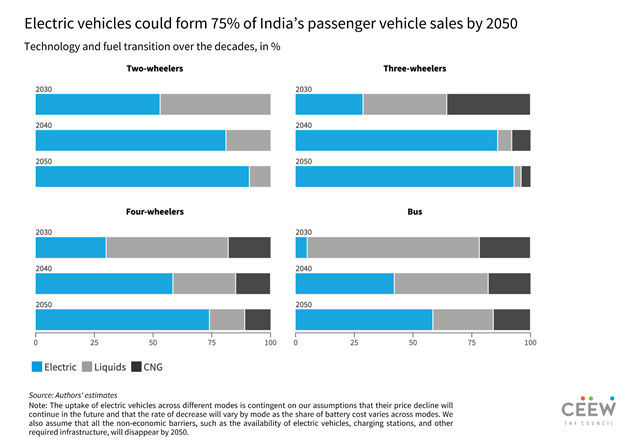Electric passenger vehicles could comprise 30% and 75% of the new vehicle sales in India by 2030 and 2050, respectively, according to an independent study released today by the Council on Energy, Environment and Water (CEEW). In fact, half of the new two-wheelers and over a quarter of new three- and four-wheelers sold in 2030 could be electric. The Centre and state governments would need to invest significantly more in charging infrastructure and support local supply chain development to support this rapid growth in electric vehicle sales.
CEEW’s ‘India Transport Energy Outlook’ study further highlighted that in the next three decades ownership of four-wheelers could grow by nine times. The ownership of two-wheelers though would saturate with rising income levels. The overwhelming shift to four-wheelers, aided by rising income levels, would significantly impact the transport sector’s energy demand and emissions. At present, India’s transport sector accounts for around 21% of the total energy consumed and produces fewer emissions compared to developed countries.
Dr Vaibhav Chaturvedi, Fellow, CEEW, said, “Energy demand from India’s transport sector is set to grow manifold over the next 30 years, in line with the expected rise in the per capita income. Therefore, decarbonising the transport sector, especially the hard-to-abate aviation sector and long-distance freight transport, is crucial for India’s short and long-term climate goals. Our policymakers should prioritise investing in developing local supply chains and charging networks for electric vehicles and create policies that would encourage adoption of public transport. At the same time, India should also seek global partnerships to develop an ecosystem to promote research and development for green hydrogen in the transport sector.”
India’s freight service demand is also expected to jump five times to 10,000 billion tonne kilometers by 2050 from nearly 2,000 billion tonne kilometers in 2020. Therefore, green hydrogen and natural gas would have to play a crucial role in reducing emissions from the freight transport sector.
The CEEW study also highlighted that decline in the share of public transport due to a surge in ownership of private vehicles and rapid growth in air travel would pose significant challenges to India’s efforts to decarbonise the transport sector.
Himani Jain, Senior Programme Lead, CEEW, said, “India is poised to witness rapid urbanisation in the coming decades and demand for houses in the cities is likely to grow substantially by 2050. With increased pressure on land as a resource, restricting ownership and use of personal vehicles would be necessary. To avoid a surge in energy demand and space from the transport sector, policymakers should encourage adoption of public transport, especially in major cities with high penetration of personal vehicles. Further, investments in the EV ecosystem would help convince customers to replace their traditional vehicles with EVs.”
In 2021, India launched two production-linked incentive schemes to attract investments in local manufacturing of electric vehicles and advanced chemistry cell batteries. On the demand side, India has been offering incentives for electric vehicle purchases through the Faster Adoption and Manufacturing of Hybrid and Electric Vehicle (FAME) scheme.






